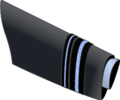The examples and perspective in this deal primarily with the United Kingdom and do not represent a worldwide view of the subject.(October 2023) |
Air vice-marshal (Air Vce Mshl or AVM) is an air officer rank used by some air forces, with origins from the Royal Air Force. [1] The rank is also used by the air forces of many countries which have historical British influence and it is sometimes used as the English translation of an equivalent rank in countries which have a non-English air force-specific rank structure.
Contents
- Australia
- Canada
- India
- United Kingdom
- Origins
- RAF insignia, command flag and star plate
- Gallery
- See also
- References
Air vice-marshal is usually equivalent to the naval rank of rear admiral or a rank of major general in an army. The rank of air vice-marshal is immediately senior to the rank of air commodore and immediately subordinate to the rank of air marshal. Since before the Second World War it has been common for air officers commanding RAF groups to hold the rank of air vice-marshal. In small air forces such as the Royal New Zealand Air Force and the Ghana Air Force, the head of the air force holds the rank of air vice-marshal.
The equivalent rank in the Women's Auxiliary Air Force, Women's Auxiliary Australian Air Force, [2] Women's Royal Air Force (until 1968) and Princess Mary's Royal Air Force Nursing Service (until 1980) was "air chief commandant".









